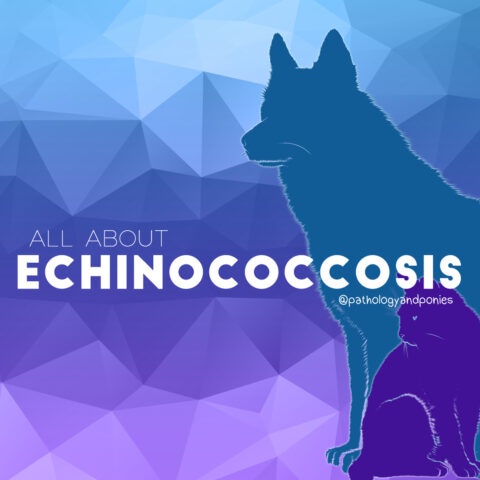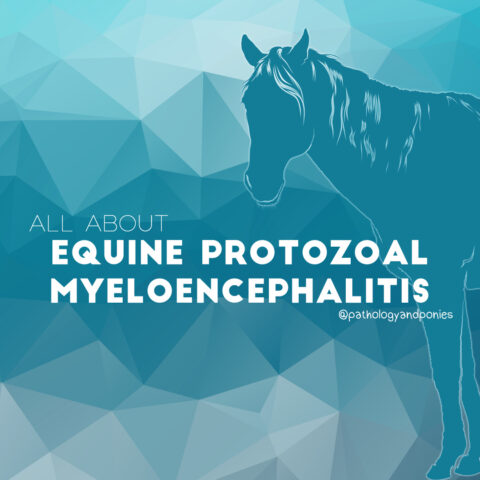
Mites are eight legged ectoparasites that infect the skin of many different species. The main mite species are Demodex and Sarcoptes, but Notoedres, Otodectes, Psoroptes, Chorioptes and Cheyletiella are also significant. Because they’re all so similar, sometimes it can be hard to keep them straight!
Demodex
Demodex most commonly affects dogs, with the most common species being Demodex canis. These mites live within the hair follicles, and are part of the normal skin flora. In fact, humans have their own Demodex species that are commonly found in and around our eyelashes! Weird. Dogs will acquire the mites from their mother during the first 3 days of life, meaning that essentially every dog will have some degree of Demodex on their skin.
For unknown reasons, sometimes the dog develops a reaction to these mites that may require treatment. Probably the most important thing to know about Demodex is that there are two presentations: localized and generalized. Localized Demodex usually occurs on the legs and face, and generally isn’t a big deal. In most cases, no treatment is needed, as the animal will spontaneously recover.
Generalized Demodex can affect large portions of the body, and is much more significant. These animals typically have an immunodeficiency affecting helper T cells, causing widespread damage to the skin as the cytotoxic T cells are hyper-activated. Thus, if you see a dog with generalized demodecosis, you should look for an underlying immune problem that may be present.
In both cases, demodecosis lesions look like greasy, oily or crusting areas of skin, often with alopecia. Sometimes, these lesions can have secondary bacterial infections as well. To confirm the diagnosis, a deep skin scraping is used (deep for Demodex) to visualize the mites, eggs and larvae.
For animals with generalized Demodex, treatment typically involves hair clipping and baths with a deep cleaning shampoo, combined with an anti-parasitic treatment. Currently, there are not many products labelled for treating Demodex, however studies have shown that moxidectin, ivermectin and some flea products can be effective. If there is a bacterial infection present, then appropriate antibiotics should also be included in the treatment plan. Unfortunately, the prognosis for these animals is rather poor, and recurrence is common.
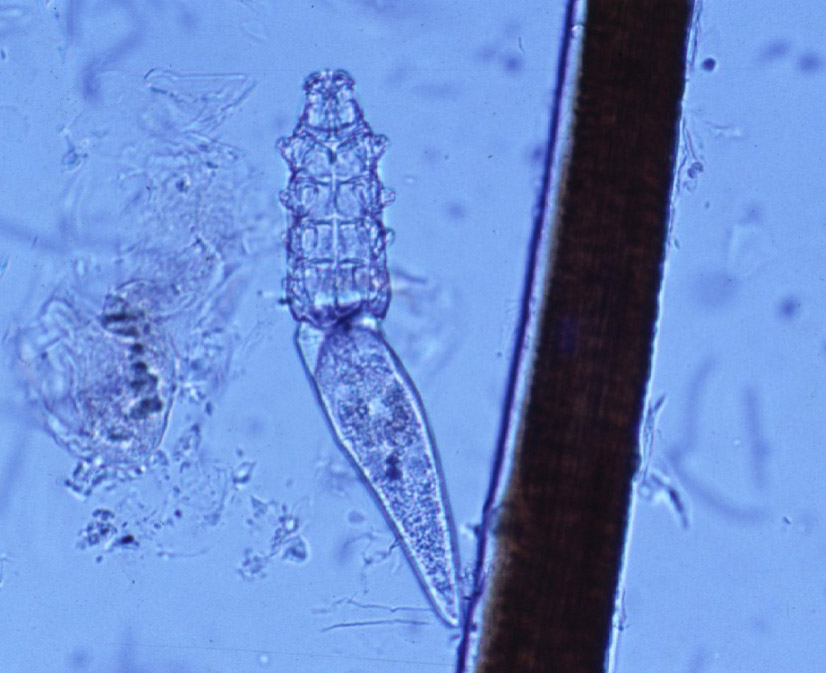
© Domingo licensed under CC BY-SA 4.0.

© Boosinger/Chang licensed under CC BY-SA 4.0.
Feline Demodecosis
Not to be outdone by the dogs, cats have their own demodecosis condition as well. Demodex cati and Demodex gatoi are also thought to be a normal skin inhabitant in cats. D. cati lives within the hair follicles, like D. canis, whereas D. gatoi lives within the superficial skin. These mites cause similar lesions to demodecosis in dogs, and can be diagnosed based on superficial and deep skin scrapings. The most effective treatment in cats appears to be lime sulfur dips, as many of the anti-parasitic medications can have severe side effects in kitties.
Sarcoptes
Sarcoptes is the cause of sarcoptic mange or scabies, and is most commonly seen in dogs. The most common species is Sarcoptes scabiei. These mites tend to live within the stratum corneum, the most superficial layer of the skin, meaning that the mites are easily transmitted between animals just by direct contact or through the environment.
Once the mites have infected the animal, they cause a hypersensitivity reaction that leads to intense pruritus. Typically, the earliest lesions of sarcoptic mange are found on the ears, head and neck, and over time progress to affecting the entire body. These lesions are typically crusted and excoriated (traumatized) due to the animal’s itching. Older lesions may become scaly, thickened and alopecic.
Sarcoptes is diagnosed through a superficial skin scraping (superficial for Sarcoptes), however the chances of identifying these mites on a scraping is relatively low. Thus, multiple scrapings may be needed, and even if no mites are found, treatment may still be warranted.
Unlike Demodex, there are labelled products for the treatment of Sarcoptes, such as selamectin. Moxidectin, milbemycin oxime and ivermectin have also been reported to be effective in some cases. For young animals, lime sulfur dips may be used. It is important to remember how easily transmitted this mite is, so all dogs within the household should be treated, even if they are not showing symptoms.
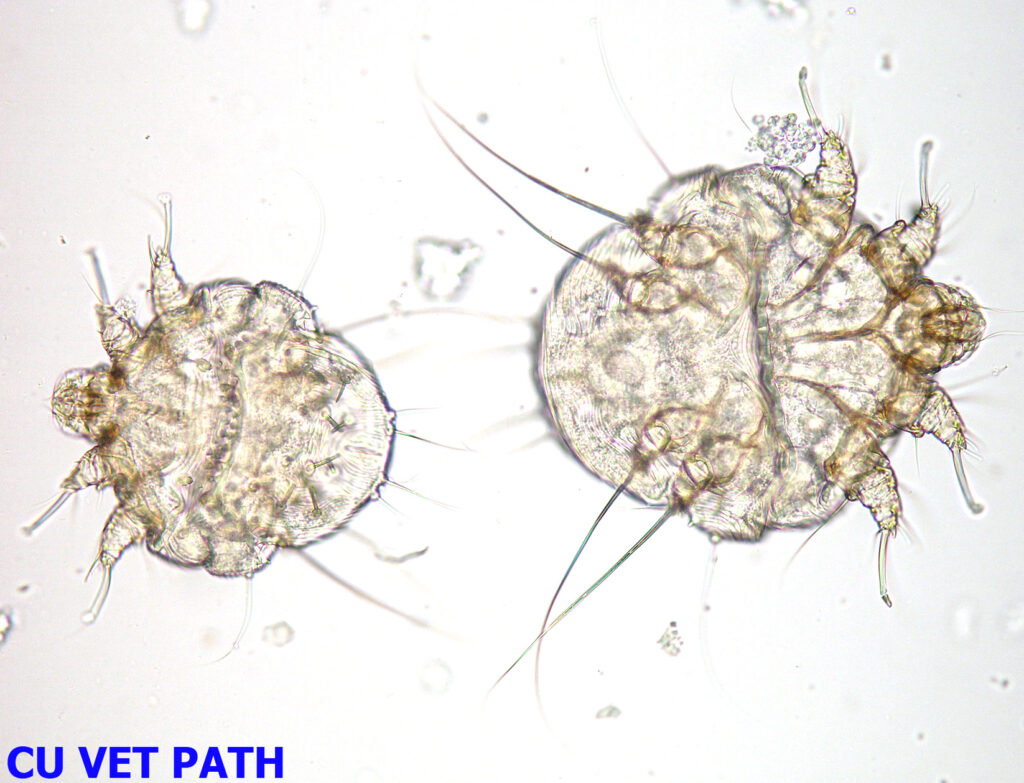
© Kesdangsakonwut licensed under CC BY-SA 4.0.

© Loukopoulos licensed under CC BY-SA 4.0.
Notoedres
Notoedric mange is caused by Notoedres cati, and most commonly affects cats. This mite is fairly uncommon, but can cause intense pruritis in cats with crusting and alopecia. Similar to Sarcoptes, these mites are best diagnosed on a superficial skin scraping, and can be treated with similar treatment options with off-label use.
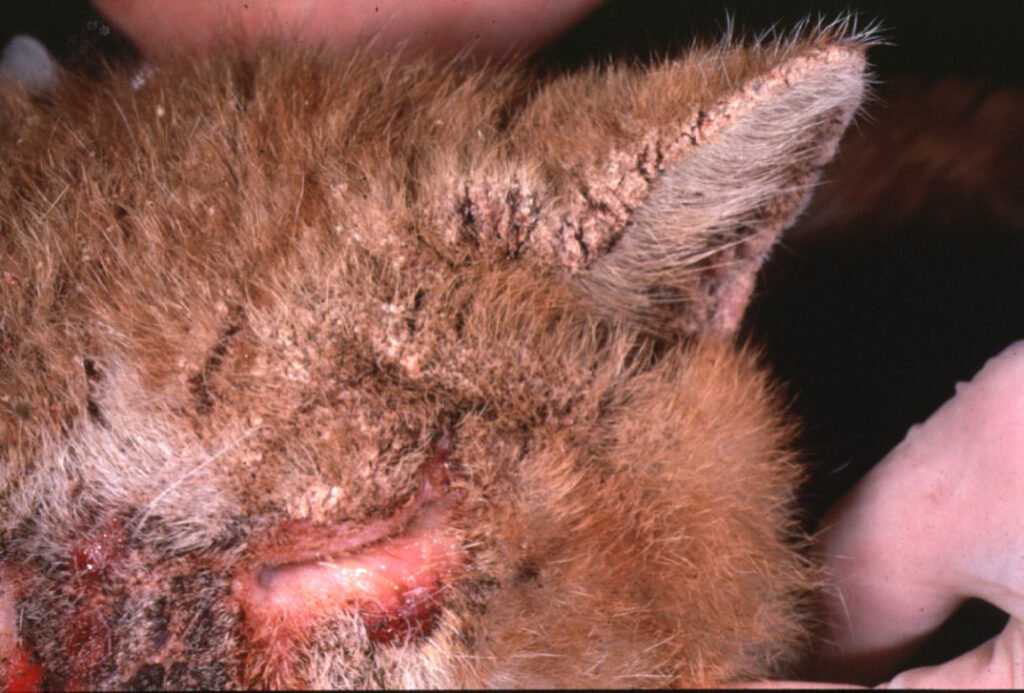
© Vtscharner licensed under CC BY-SA 4.0.
Otodectes
Otodectes cynotis causes external ear infections, primarily in cats. These cats typically show signs of head shaking, ear scratching and may even have drooping ears. On physical exam, you may see dark brown cerumen accumulating within the ear canals, and potentially pus in severe cases. Treatment typically involves off-label selamectin or moxidectin, combined with ear cleaning to remove the cerumen build-up.
Psoroptes
The most common Psoroptes mite is Psoroptes ovis, which typically affects sheep. This mite has been eradicated in North America, however you may see cases elsewhere in the world. Like the other types of mange, these mites cause scaly, crusting lesions across the body that are intensely pruritic. Typically, these infections are treated with lime sulfur dips.
Psoroptes cuniculi can also affect the ears of rabbits, leading to itching, head shaking and scratching. Rabbits with this infection may be treated with off-label ivermectin or selamectin. Like other infectious mite species, it is important to treat all rabbits in the household, due to its easy transmission by direct contact.

© Jakowski licensed under CC BY-SA 4.0.
Chorioptes
Chorioptic mange is most commonly seen in horses, and is caused by Chorioptes bovis. These mites are typically found in the feathered lower limbs of draft horses, causing an itchy, alopecic and crusting dermatitis. These horses may stamp their feet or rub their legs against objects to try and relieve the itching. Thankfully, these mites can be treated by clipping the hair in the area and treating with a lime sulfur dip.
Cheyletiella
Although there are Cheyletiella mites in many species, the main one to consider is Cheyletiella parasitovorax, which infects rabbits. This mite infection is often called “walking dandruff”. The mites cause scaling and pruritus, similar to types of mange. Because they tend to live on the surface of the skin, they are best diagnosed using a tape preparation or superficial skin scraping. Treatment typically involves lime sulfur dips or off-label anti-parasitic use for all animals within the household.

© Ramos-Vara licensed under CC BY-SA 4.0.
Comparison Table
| Mite | Species Commonly Affected | Diagnostic Method |
|---|---|---|
| Demodex | Dogs, cats | Deep skin scraping |
| Sarcoptes | Dogs | Superficial skin scraping |
| Notoedres | Cats | Superficial skin scraping |
| Otodectes | Cats | Ear cytology |
| Psoroptes ovis | Rabbits | Ear cytology |
| Chorioptes | Horses | Skin scraping |
| Cheyletiella | Rabbits | Tape preparation Superficial skin scraping |
A brief note on treatment:
It is important to note that basically every mite infection can be treated by lime sulfur dips. This is a relatively simple (but messy) way of treating many species in a safe way.
You may also notice that many of the anti-parasitic medications are used off-label for mite infestations. It is important to consult resources about dosage, side effects, and species use prior to treatment. This is especially true in food animal species. If you have concerns or are unsure, consult with FARAD about withdrawal times or usage.

Zachary JF. Pathologic Basis of Veterinary Disease, Sixth Edition.
Dryden MW. Mange in Dogs and Cats. Merck Veterinary Manual 2016.


